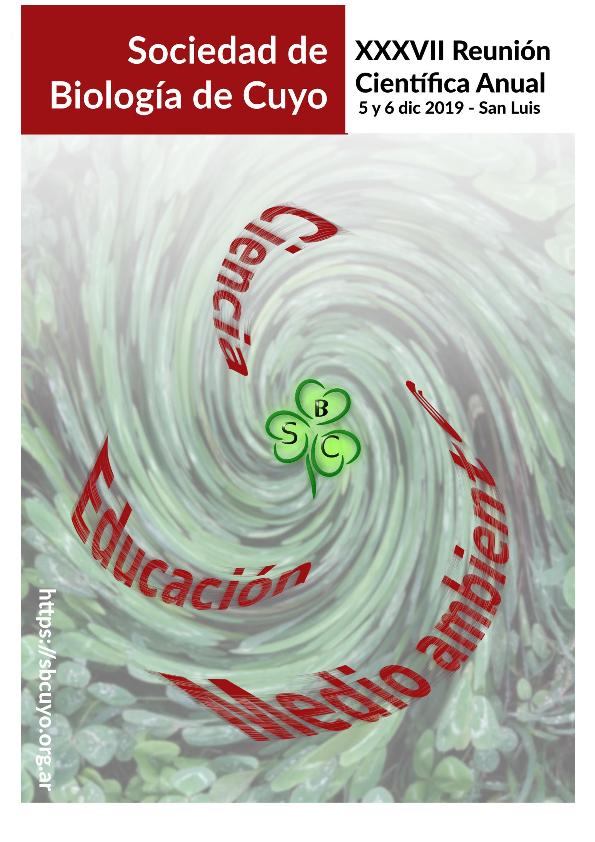Mostrar el registro sencillo del ítem
dc.contributor.author
Mariqueo, Betsabé L.
dc.contributor.author
Diaz Guevara, María Clara
dc.contributor.author
Rosales, Gabriel

dc.contributor.author
Filippa, Veronica Palmira

dc.contributor.author
Perez, Edith

dc.contributor.author
Mohamed, Fabian Heber

dc.date.available
2022-06-16T17:57:10Z
dc.date.issued
2020
dc.identifier.citation
Seasonal study of the expression of the s-100 protein in pituitary pars nervosa of viscacha (Lagostomus maximus maximus); XXXVII Reunión Científica Anual de la Sociedad de Biología de Cuyo: Educación, Salud y ambiente: Los nuevos desafíos en las Ciencias Biológicas; San Luis; Argentina; 2019; 61-61
dc.identifier.uri
http://hdl.handle.net/11336/159993
dc.description.abstract
The pars nervosa (PN) of the neurohypophysis is mainly constituted by pituicytes and other neuroglial cells such as microglial cells, astrocytes and oligodendrocytes, endothelial cells of blood vessels and amylinic axons. The PN pituicytes express the S-100 protein that has a regulatory role within the cell and on different target cells. The aim of this work was to study the seasonal expression of S100 protein in pituitary PN of adult male viscachas (Lagostomus maximus maximus). The animals were captured in their habitat during the most representative months of their annual reproductive cycle. This cycle has three periods: reproductive (RepP), gonadal regression (RegP), and gonadal recovery (RecP). Four pituitary glands of each period were removed and processed for optical microscopy. The S-100 protein was used as markers of pituicytes and their expression was detected by immunohistochemistry. The primary antibody used was the rabbit polyclonal anti-S-100 protein. Immunohistochemical staining was performed using a streptavidinbiotin-peroxidase complex method with the 3, 3’- diaminobenzidine tetrahydrochloride (DAB) as chromogen. A morphometric study was performed and the percentage of immunopositive area for S-100 (% IA-S-100) was measured. The results obtained from these periods were statistically analyzed. Most of the pituicytes presented a cytoplamic immunostaining pattern. However, some of them also exhibited nuclear staining. The nuclei were round, oval and irregular in shape, with varying density of chromatin and an evident nucleolus. Numerous immunostained cytoplasmic processes in contact with blood vessels were observed. The % IA-S-100 varied throughout the annual reproductive cycle. The % IA during the RepP (13.09 ± 1.49) and RegP (9.77 ± 1.56) were significantly lower than in the RecP (25.61 ± 2.36; P < 0.001). These results demonstrated that the highest expression of S-100 protein was in the RecP. This period agrees with the increase of seasonal rainfall pattern during spring, so the viscachas have greater water availability in the environment. It is likely that the pituicytes participate in the seasonal regulation of the neurohormonal secretion through the expression of the S-100 protein. This protein is associated with functions such as modulation of enzymatic activity, stimulation of adenylate cyclase, maintenance of cell shape and mobility. However, further research is needed to elucidate the relationship between S-100 expression and the neurohormonal PN secretion of Lagostomus.
dc.format
application/pdf
dc.language.iso
eng
dc.publisher
Sociedad de Biología de Cuyo
dc.rights
info:eu-repo/semantics/openAccess
dc.rights.uri
https://creativecommons.org/licenses/by-nc-sa/2.5/ar/
dc.subject
LAGOSTOMUS
dc.subject
PITUITARY
dc.subject
S-100 PROTEIN
dc.subject
SEASONAL
dc.subject.classification
Bioquímica y Biología Molecular

dc.subject.classification
Medicina Básica

dc.subject.classification
CIENCIAS MÉDICAS Y DE LA SALUD

dc.title
Seasonal study of the expression of the s-100 protein in pituitary pars nervosa of viscacha (Lagostomus maximus maximus)
dc.type
info:eu-repo/semantics/publishedVersion
dc.type
info:eu-repo/semantics/conferenceObject
dc.type
info:ar-repo/semantics/documento de conferencia
dc.date.updated
2022-06-15T15:49:02Z
dc.journal.pagination
61-61
dc.journal.pais
Argentina

dc.journal.ciudad
San Luis
dc.description.fil
Fil: Mariqueo, Betsabé L.. Consejo Interuniversitario Nacional. - Ministerio de Educacion, Cultura, Ciencia y Tecnologia. Consejo Interuniversitario Nacional.; Argentina. Universidad Nacional de San Luis. Facultad de Química, Bioquímica y Farmacia. Departamento de Bioquímica y Ciencias Biológicas; Argentina
dc.description.fil
Fil: Diaz Guevara, María Clara. Universidad Nacional de San Luis. Facultad de Química, Bioquímica y Farmacia. Departamento de Bioquímica y Ciencias Biológicas; Argentina
dc.description.fil
Fil: Rosales, Gabriel. Consejo Nacional de Investigaciones Científicas y Técnicas. Centro Científico Tecnológico Conicet - San Luis; Argentina. Consejo Interuniversitario Nacional. - Ministerio de Educacion, Cultura, Ciencia y Tecnologia. Consejo Interuniversitario Nacional.; Argentina. Universidad Nacional de San Luis. Facultad de Química, Bioquímica y Farmacia. Departamento de Bioquímica y Ciencias Biológicas; Argentina
dc.description.fil
Fil: Filippa, Veronica Palmira. Consejo Nacional de Investigaciones Científicas y Técnicas. Centro Científico Tecnológico Conicet - San Luis; Argentina. Universidad Nacional de San Luis. Facultad de Química, Bioquímica y Farmacia. Departamento de Bioquímica y Ciencias Biológicas; Argentina. Consejo Interuniversitario Nacional. - Ministerio de Educacion, Cultura, Ciencia y Tecnologia. Consejo Interuniversitario Nacional.; Argentina
dc.description.fil
Fil: Perez, Edith. Universidad Nacional de San Luis. Facultad de Química, Bioquímica y Farmacia. Departamento de Bioquímica y Ciencias Biológicas; Argentina
dc.description.fil
Fil: Mohamed, Fabian Heber. Universidad Nacional de San Luis. Facultad de Química, Bioquímica y Farmacia. Departamento de Bioquímica y Ciencias Biológicas; Argentina. Consejo Interuniversitario Nacional. - Ministerio de Educacion, Cultura, Ciencia y Tecnologia. Consejo Interuniversitario Nacional.; Argentina
dc.relation.alternativeid
info:eu-repo/semantics/altIdentifier/url/https://sbcuyo.org.ar/xxxv-reunion-cientifica-anual/#:~:text=Lugar%20y%20Fecha,Descargar%20mapa.
dc.conicet.rol
Autor

dc.conicet.rol
Autor

dc.conicet.rol
Autor

dc.conicet.rol
Autor

dc.conicet.rol
Autor

dc.conicet.rol
Autor

dc.coverage
Nacional
dc.type.subtype
Reunión
dc.description.nombreEvento
XXXVII Reunión Científica Anual de la Sociedad de Biología de Cuyo: Educación, Salud y ambiente: Los nuevos desafíos en las Ciencias Biológicas
dc.date.evento
2019-12-05
dc.description.ciudadEvento
San Luis
dc.description.paisEvento
Argentina

dc.type.publicacion
Book
dc.description.institucionOrganizadora
Sociedad de Biología de Cuyo
dc.source.libro
Libro de Resúmenes XXXVII Reunión Científica Anual Sociedad de Biología de Cuyo
dc.source.revista
Biocell
dc.date.eventoHasta
2019-12-06
dc.type
Reunión
Archivos asociados
